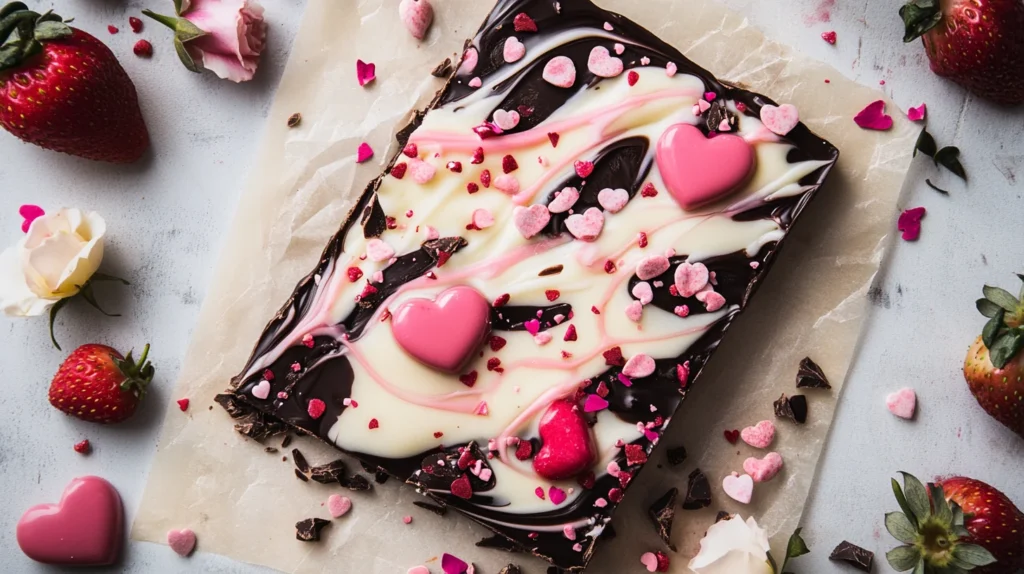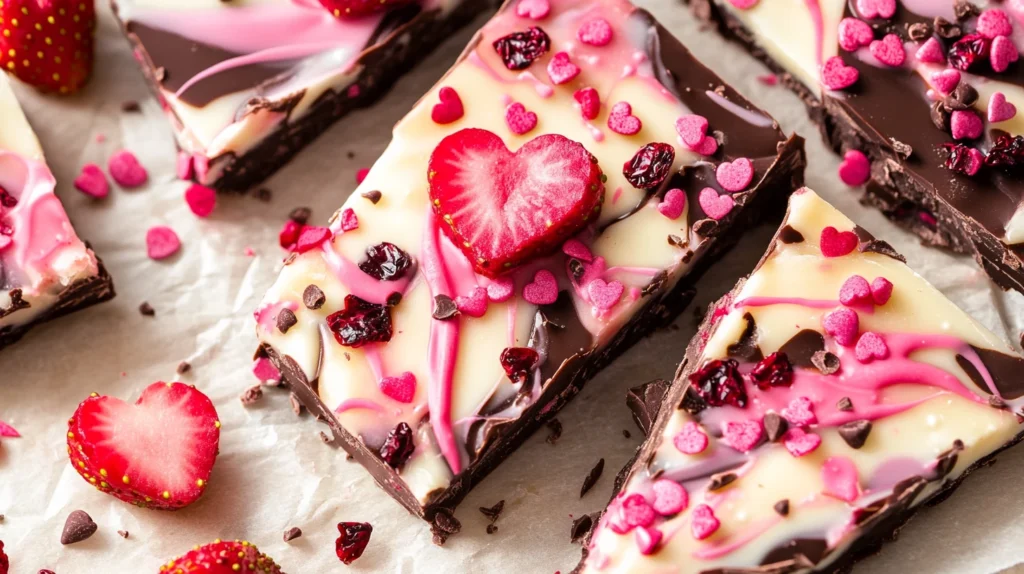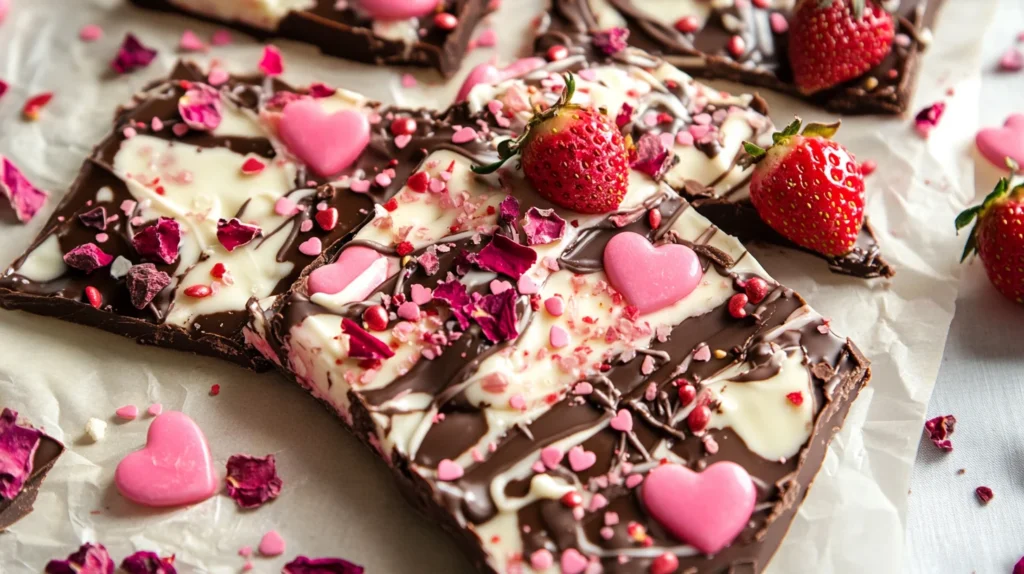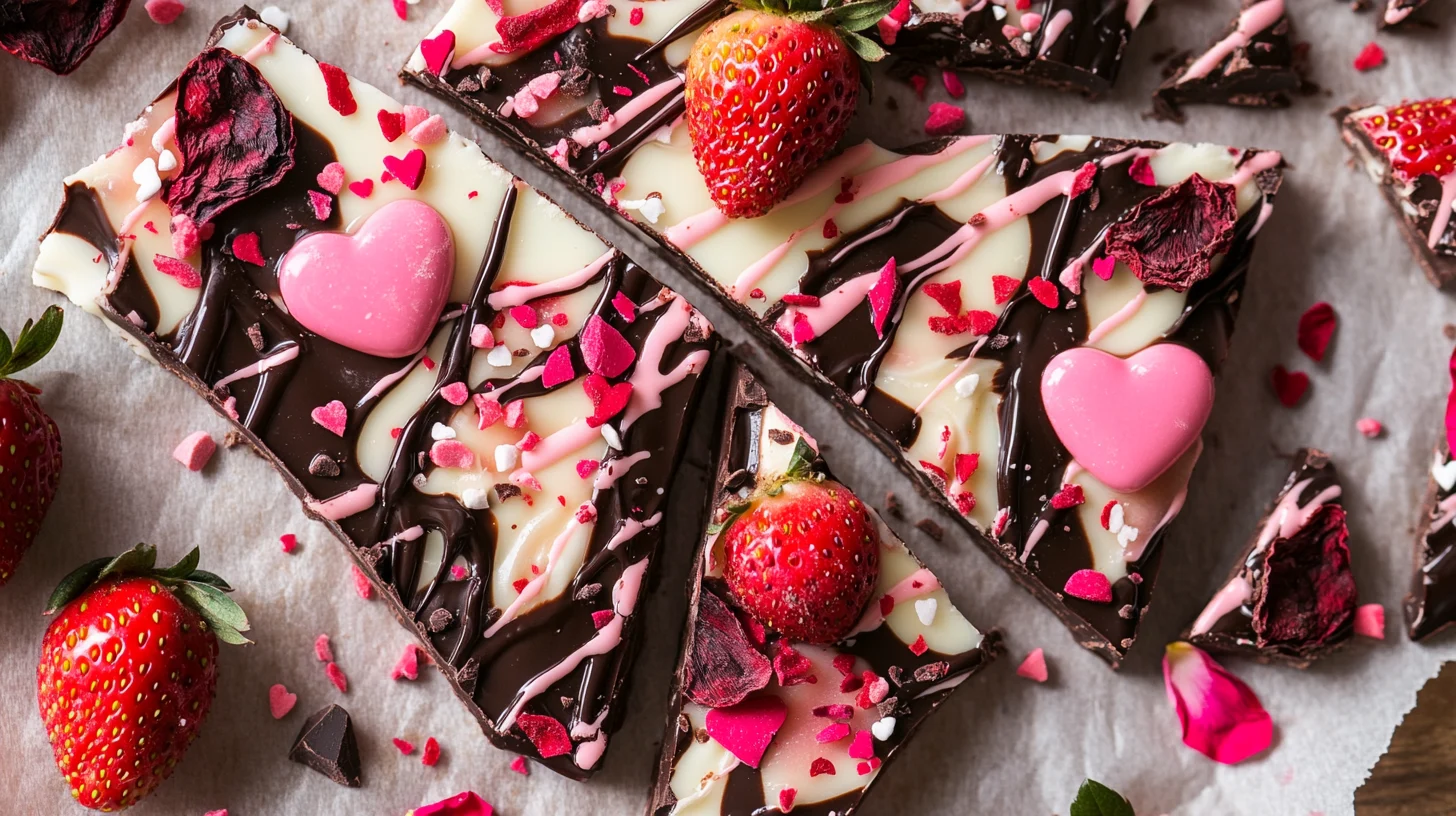Chocolate Bark Recipe: Indulge Your Loved Ones with This Irresistible Valentine’s Treat
Valentine’s Day is a time to express love and affection, and what better way to do it than with a delightful homemade treat? This Valentine’s Chocolate Bark Recipe promises to add a personal touch to your gifts while satisfying sweet cravings. With its versatility, ease of preparation, and eye-catching presentation, chocolate bark has become a favorite among those looking to impress their loved ones without spending hours in the kitchen.
Introduction to Chocolate Bark
Chocolate bark is not just a simple dessert; it’s an experience that combines creativity, flavor, and heartfelt intentions. As Valentine’s Day approaches, many seek ways to convey their emotions, and making chocolate bark is an excellent option.
What is Chocolate Bark?
At its core, chocolate bark is a confection made by melting chocolate and spreading it into a thin layer before adding toppings. Once cooled and hardened, the chocolate is broken into irregular pieces which resemble tree bark—hence the name. The beauty of chocolate bark lies in its simplicity; it is easy to make yet can be transformed into a gourmet delicacy with various toppings.
Chocolate bark can serve as a canvas for your culinary creativity. By choosing your preferred type of chocolate and experimenting with diverse toppings, you can create a treat that reflects the tastes of the recipient. Whether you’re a novice or a seasoned baker, chocolate bark allows for personalization in both flavor and presentation.
The Appeal of Homemade Treats for Valentine’s Day
In a world filled with commercialized gifts, homemade treats stand out as a thoughtful gesture of love. When you take the time to prepare something from scratch, it shows dedication and consideration, which are essential elements of a meaningful gift.
Furthermore, homemade treats like chocolate bark provide an opportunity to bond with your loved one during the preparation process. It becomes not just about the end product but also about creating memories together. Whether you’re cooking with kids or surprising a partner, making chocolate bark can be a joyful and intimate experience.
Why Chocolate Bark is a Perfect Gift
Chocolate bark makes for an ideal gift on Valentine’s Day for several reasons. First, it is highly customizable, allowing you to cater to specific tastes and preferences. The ability to mix various chocolates, nuts, fruits, and spices means you can design a one-of-a-kind creation that feels special and personal.
Second, chocolate bark is visually appealing, aiding in its role as a gift. Beautifully arranged and packaged, it can evoke feelings of warmth and affection, which perfectly aligns with the spirit of Valentine’s Day. Lastly, unlike other confections that may require advanced baking skills, chocolate bark is straightforward to make, ensuring that anyone can partake in the fun of creating a delicious treat.

Ingredients Needed
To make the perfect batch of chocolate bark, gathering the right ingredients is crucial. This section will guide you through the essential components needed to create a delightful chocolate experience.
Essential Ingredients for Classic Chocolate Bark
The foundation of any great chocolate bark is quality chocolate. You have options: dark, milk, or white chocolate all come together beautifully to create a delicious base.
When it comes to selecting chocolate, consider the flavor profile you want to achieve. Dark chocolate offers a rich, slightly bitter taste that pairs wonderfully with sweet toppings. Milk chocolate is creamier, lending itself well to combinations with nuts and caramel. White chocolate, while technically not chocolate, provides a sweet, vanilla-like flavor that works well with fruity toppings.
Other essential ingredients might include sea salt for a savory contrast, crushed graham crackers for crunch, or sprinkles to add color and whimsy. The key is to use high-quality ingredients, as they will significantly impact the final flavor of your chocolate bark.
Optional Add-ins for Personalization
While the classic chocolate bark is delicious on its own, you can elevate your creation with various optional add-ins. Incorporating ingredients such as dried fruit, nuts, or even spices can enhance both the taste and texture of your bark.
Consider adding dried cranberries or cherries to bring a tart contrast to the sweetness of the chocolate. Nuts, whether almonds, pecans, or hazelnuts, can add a delightful crunch and richness to your bark. If you’re feeling adventurous, try incorporating spices like cinnamon or cayenne pepper to create a unique flavor profile that will surprise and delight your loved ones.
Choosing the Right Chocolate: Dark, Milk, or White?
Choosing the right type of chocolate for your bark is vital since each variety imparts a different taste and experience. Dark chocolate, known for its high cocoa content, tends to have a more intense flavor and is often considered healthier due to its antioxidants.
Milk chocolate, on the other hand, is sweeter and creamier, making it a popular choice for those who prefer a milder flavor. Its smooth texture complements many toppings, particularly fruits and marshmallows. White chocolate is an excellent option for those who enjoy sweetness without the bitterness of cocoa, though keep in mind that it may not appeal to everyone.
Ultimately, the choice of chocolate should align with the preferences of the person receiving the gift. Experimenting with different types can lead to exciting new flavors, so don’t hesitate to mix and match.

Step-by-Step Instructions
Once you’ve gathered your ingredients, it’s time to roll up your sleeves and start creating this delectable treat. The preparation process is straightforward and enjoyable, allowing you to get creative along the way.
Preparing Your Workspace and Tools
Before diving into the melting process, ensure that your workspace is clean and organized. Gather all your tools, including a baking sheet lined with parchment paper, a microwave-safe bowl or double boiler, and spatulas for mixing.
Creating a conducive environment also involves minimizing distractions. Set aside enough time to focus on your chocolate bark without interruptions, as this will elevate the overall experience. A calm kitchen atmosphere can lead to a more enjoyable cooking session and ultimately yield better results.
Melting the Chocolate: Best Practices
Melting chocolate requires patience and care to avoid burning or seizing. If using a microwave, heat the chocolate in short bursts of 20-30 seconds, stirring between intervals until completely melted.
Alternatively, a double boiler method can offer more control. Fill a saucepan with water and place a heatproof bowl on top, ensuring the bottom doesn’t touch the water. Stir the chocolate continuously until it’s smooth and glossy.
Regardless of the method chosen, maintaining a low heat is crucial. Chocolate can go from perfectly melted to burnt in minutes, so stay attentive throughout the process.
Adding Toppings: Creative Ideas
Once your chocolate is melted and ready, it’s time to unleash your creativity with toppings. Pour the melted chocolate onto the prepared baking sheet, spreading it into an even layer.
Now comes the fun part—add your toppings! Sprinkle chopped nuts, dried fruits, or colorful sprinkles over the chocolate while it’s still warm. For an extra touch, drizzle contrasting colored chocolate on top or incorporate edible glitter for added sparkle.
Allow your imagination to run wild; the sky’s the limit! Not only do these toppings enhance the flavor, but they also make the chocolate bark visually stunning, sure to impress anyone who lays eyes on it.
Setting the Chocolate Bark: for Success
After adding toppings, let the chocolate cool and set. You can either leave it at room temperature for a couple of hours or speed up the process by placing it in the refrigerator for approximately 30 minutes.
Once the chocolate has hardened, it’s time to break it into pieces. Using your hands or a knife, divide the bark into irregular chunks, resembling the natural look of tree bark. This rustic appearance adds charm to the finished product and ensures that each piece is unique.
Variations of Chocolate Bark
One of the most exciting aspects of creating chocolate bark is the endless variations you can explore. From seasonal flavors to dietary considerations, there’s a world of possibilities waiting for you.
Seasonal Flavors: Incorporate Valentine’s Themes
Embrace the spirit of Valentine’s Day by incorporating seasonal flavors into your chocolate bark. Consider adding red or pink-hued toppings, such as strawberries or raspberries, to represent the colors of love.
You can also experiment with heart-shaped sprinkles or candies to enhance the romantic theme. Infusing your chocolate with flavors like raspberry or cherry extract can elevate the overall taste, creating a treat that is not only beautiful but deliciously thematic too.
Dietary Considerations: Vegan and Gluten-Free Options
Chocolate bark can easily be adapted to suit various dietary needs, making it accessible to everyone. For vegans, opt for dairy-free chocolate, which is now widely available in stores. Additionally, check that your chosen toppings are vegan-friendly, avoiding those that contain animal products.
If gluten is a concern, ensure that any cookies, cereals, or other crunchy toppings are labeled gluten-free. This inclusivity means that no one has to miss out on enjoying this delightful treat, regardless of dietary restrictions.
Uniquebinations: Fruit, Nuts, and Spices
For those feeling adventurous, consider exploring unique combinations of fruits, nuts, and spices to create signature flavors. Think about pairing spicy chili flakes with dark chocolate for an exhilarating kick, or combining citrus zest with white chocolate for a refreshing twist.
Some other intriguing combinations could include candied ginger and macadamia nuts, or lavender-infused chocolate topped with pistachios. Don’t shy away from thinking outside the box! The goal is to create something unexpected and delightful that showcases your individual style.

Presentation and Storage Tips
Now that your delightful chocolate bark is made, it’s time to think about how to present and store your creation. Proper packaging and storage will ensure that your bark stays fresh and maintains its beautiful appearance.
Creative Ways to Package Your Chocolate Bark
Packaging your chocolate bark can elevate its presentation dramatically, transforming it from a simple treat into a thoughtful gift. Consider using decorative boxes or tins adorned with ribbons to add a special touch. Alternatively, wrapping your bark in cellophane and tying it with a bow creates a charming display.
For an additional personal touch, attach a handwritten note expressing your love or sweet sentiments. This added gesture makes your gift even more memorable and conveys the effort you put into creating it.
How to Store Chocolate Bark for Longer Freshness
Proper storage plays a crucial role in preserving the freshness of your chocolate bark. To keep it at its best, store the bark in an airtight container in a cool, dry place. Avoid exposing it to direct sunlight or heat, as this can cause the chocolate to melt or bloom.
If you need to store the bark for an extended period, refrigerating it is an option, but be sure to wrap it securely to prevent moisture absorption. Under optimal conditions, chocolate bark can last for several weeks, allowing you to enjoy your creation long after Valentine’s Day has passed.
FAQ:
1. Why is chocolate called “bark”?
Chocolate bark gets its name from its appearance. When spread out in a thin, uneven layer and broken into jagged pieces, it resembles the rough surface or bark of a tree. It’s a rustic, casual type of chocolate treat that often includes toppings like nuts, dried fruits, or candies.
2. How is chocolate related to Valentine’s Day?
Chocolate became linked to Valentine’s Day largely due to its long-standing reputation as an aphrodisiac and symbol of love. In the 19th century, Richard Cadbury (of the famous Cadbury chocolate brand) capitalized on this by marketing chocolates in heart-shaped boxes decorated with cupids and roses, making them the perfect romantic gift. The tradition stuck, and today, gifting chocolate is practically synonymous with Valentine’s Day.
3. What’s the difference between a chocolate bar and chocolate bark?
- Chocolate Bar:
A uniform, solid piece of chocolate, usually molded into a specific shape or size. It can be plain or contain fillings like caramel, nuts, or nougat. Think of brands like Hershey’s, Snickers, or Lindt. - Chocolate Bark:
A more free-form treat made by spreading melted chocolate into a thin layer and topping it with various ingredients like nuts, dried fruits, or candy pieces. Once it hardens, it’s broken into irregular, rustic pieces. It’s more of a homemade or artisanal vibe compared to the precise molding of a chocolate bar.
4. What chocolate is good for bark?
- High-Quality Chocolate: Use good quality chocolate (like couverture chocolate) for the best taste and texture. Brands like Ghirardelli, Valrhona, or Callebaut are great options.
- Types of Chocolate:
- Dark Chocolate: Rich and less sweet, great for pairing with tart toppings like dried cranberries or sea salt.
- Milk Chocolate: Sweeter and creamier, ideal for nuts, caramel, or toffee bits.
- White Chocolate: Sweet and buttery, pairs well with colorful toppings like crushed peppermint or dried berries.
Tip: Tempering the chocolate (melting and cooling it in a controlled way) gives it a nice snap and glossy finish, especially if you’re gifting it!
Conclusion
In conclusion, creating a Valentine’s Chocolate Bark Recipe is an enjoyable and rewarding endeavor that allows you to share love and sweetness with those who matter most to you. The process of making chocolate bark not only provides a delicious treat but also serves as a wonderful opportunity to engage in creativity, celebrate relationships, and spread joy.
By following the detailed steps outlined above, you can craft a one-of-a-kind chocolate bark tailored to your taste and the preferences of your loved ones. With endless variations and personalized touches, your homemade chocolate bark is sure to be a hit this Valentine’s Day, leaving a lasting impression that goes beyond mere indulgence.
So gather your ingredients, turn on some romantic music, and immerse yourself in the art of crafting this delightful treat. It’s not just about the chocolate—it’s about expressing love, creativity, and thoughtfulness in every flavorful bite.
Try More Tasty Recipes
Craving more flavorful dishes? Explore these delicious recipe ideas:
Pancake Breakfast – Fluffy Delights for Every Gathering


4 Comments-
Pingback: Strawberry Kiss Cookies: Irresistible Valentine's Day Treats
-
Pingback: Experience a Delightful Popcorn Balls Recipe – A Sweet Nostalgic Treat for Everyone
-
Pingback: Savor the Flavor - Indulge in Delicious Garlic Parmesan Chicken Pasta
-
Pingback: Discover the Irresistible Spanish Rice Recipe That Everyone Will Love